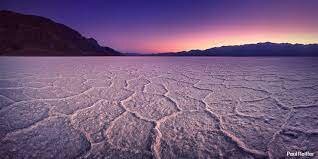The hottest places on Earth are changing and we are living adjacent to (if not in) one. The following article from Science is by Richard Stone (21 May 2021 Vol 372, Issue 6544)
***
Death Valley holds the record for the highest air temperature on the planet: On 10 July 1913, temperatures at the aptly named Furnace Creek area in the California desert reached a blistering 56.7°C (134.1°F). Average summer temperatures, meanwhile, often rise above 45°C (113°F).
But when it comes to surface temperature, two spots have Death Valley beat. A new analysis of high-resolution satellite data finds the Lut Desert in Iran and the Sonoran Desert along the Mexican-U.S. border have recently reached a sizzling 80.8°C (177.4°F).
More than 11,000 World Meteorological Organization manned and automated weather stations measure air temperatures in the shade, in ventilated hutches about 1.5 meters above ground level. But vast swaths of Earth’s surface, especially in remote regions, lack these instruments, leaving them out of the record books.
For the past 2 decades, a pair of Earth-observing satellites equipped with NASA’s Moderate Resolution Imaging Spectroradiometer (MODIS)—an instrument that measures everything from ozone levels to phytoplankton abundance—have scanned the entire globe, day in and day out. In areas without cloud cover, MODIS measures the infrared heat emitted by surfaces to take their temperature—essentially, how the soil, dirt, or ice would feel if touched.
Surface temperatures tend to run hotter than the air above, especially on sunny days when surfaces are heated both by air and the Sun’s radiant energy. “Think of your car sitting in a parking lot on a summer day and how the handle burns your fingers. Or the sand burning your feet at the beach,” says ecologist David Mildrexler of the conservation organization Eastern Oregon Legacy Lands.
In 2011, Mildrexler and his colleagues gleaned from MODIS data that summer temperatures routinely soared above 60°C (140°F) in arid regions, with a high of 70.7°C (159.3°F) in Lut in 2005. Since that study, software improvements have sharpened MODIS’s resolution from 5-kilometer pixels to 1-kilometer pixels, bringing even hotter spots into focus. Lut hit its all-time high in 2018, a record the Sonoran, in a weird coincidence, matched the next summer, Yunxia Zhao of the University of California, Irvine, and colleagues report this month in the Bulletin of the American Meteorological Society.
But with its “consistently hot footprint over a large area,” says Mildrexler, who was not involved in the present study, “the Lut Desert has really emerged as the hottest place on Earth.”
Zhao and her colleagues uncovered other superlatives. The maximum temperature swing in a single day was 81.8°C (147.3°F), from –23.7°C (–10.7°F) to 58.1°C (136.6°F) on 20 July 2006 in China’s Qaidam Basin, a crescent-shaped depression hemmed in by mountains on the Tibetan Plateau. And the coldest spot on our planet? No big surprise: Antarctica. But a satellite reading of –110.9°C (–167.6°F) in 2016 is more than 20° chillier than the coldest air temperature recorded in 1983.
It’s unclear whether climate change is driving up surface temperatures, Zhao says. But she notes that the Sonoran’s highs coincided with La Niña, a climate oscillation featuring cooler surface temperatures in the central Pacific Ocean and drier desert conditions.
Higher temperatures are bad news for desert creatures being pushed to the edge of their heat tolerances. “These extremes are really laying it on the ecosystems,” Mildrexler says. On the flip side, he says, the data reveal an impressive cooling effect of forests. Trees tap water with their deep roots and dissipate heat through transpiration, he notes, which cools their canopies and the surrounding air. “That keeps maximum temperatures down and protects biodiversity.”
And that offers a lesson for urban planners, Mildrexler says: Greener really is cooler.

